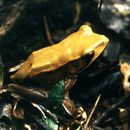Distribution and Habitat
provided by AmphibiaWeb articles
Endemic to India. Distributed widely in the Western Ghats, at elevations from 500-2,000 m asl. It is found in various type of tropical forest, including evergreen moist forest, semi-evergreen moist forest, and dry deciduous forest. This species inhabits leaf litter on the forest floor (Stuart et al. 2008).
Jerdon, T. C. (1853). ''Catalogue of the reptiles inhabiting the peninsula of India.'' Journal of the Asiatic Society of Bengal, 22, 522-534.
Life History, Abundance, Activity, and Special Behaviors
provided by AmphibiaWeb articles
Breeds in ponds and large lakes, both natural and artificial (Stuart et al. 2008).
Life History, Abundance, Activity, and Special Behaviors
provided by AmphibiaWeb articles
This is an adaptable species which can tolerate not only different forest type but also some habitat degradation. Although it can be locally abundant, population numbers are thought to be decreasing due mainly to habitat loss. Its forest habitats are being converted for agricultural use, including tea, coffee, and eucalyptus plantations, and cut down for timber and wood use. In addition, this species is subject to roadkills during breeding season, when frogs migrate to breeding habitats. It does occur within many protected areas, and it is also under national protection (Stuart et al. 2008).
Relation to Humans
provided by AmphibiaWeb articles
Tadpoles are collected for human consumption (Stuart et al. 2008).

